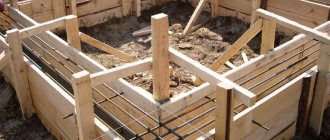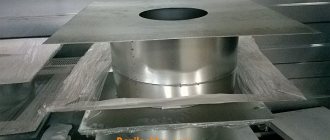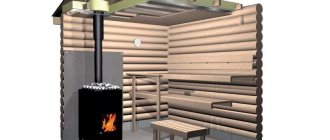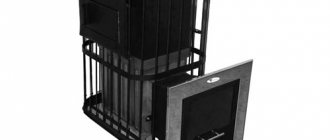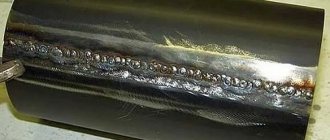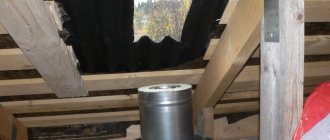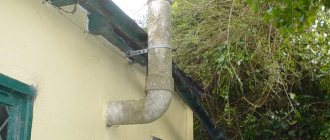The overwhelming number of owners of suburban housing cannot consider it complete if it is not supplemented with a good bathhouse. Not some kind of ersatz sauna in a dedicated, well-insulated room, where you can really use electricity to raise the temperature, but a real one, with wooden shelves and a stove-stove! The presence of an electric or gas sauna stove somewhat simplifies the operation of the sauna, but, again, it leads away from the truly faithful ritual, honed over centuries. And without the smell of burning wood, without the characteristic aroma of smoke from carefully selected logs, the bathhouse loses a lot.
Spark arrester for a chimney for a bathhouse - how to make it yourself
The best option, of course, is a wood-burning sauna stove, and many people strive for just that. But this imposes many responsibilities on the potential owner regarding the special strictness of fire safety requirements. In particular, the chimney will require close attention, the incorrect design or malfunctions of which often become the causes of emergency incidents, including those with very serious consequences. One of the dangers is the scattering of sparks from the mouth of the chimney. To prevent the serious consequences of this phenomenon, it is necessary to install a spark arrester on the chimney for the bathhouse. What it is, how it works and whether it can be made independently - all this is discussed in the proposed publication.
The principle of the design and operation of the spark arrester
What are the sparks that sometimes fly out so beautifully in whole sheaves from chimneys? Yes, this is nothing more than particles of solid fuel that have not burned to the end, picked up by the flow of hot combustion products rising to the top. In other words, small embers that continue to burn or smolder. The spectacle, yes, can indeed be beautiful, but the consequences of such “holiday illumination” are sometimes very depressing.
Read also: How to access ramp from iPhone
The owner of the bathhouse, seeing such “fireworks” over his property, should not admire the beauty, but grab his head and immediately take action!
Expert opinion: Afanasyev E.V. Chief editor of the project. Engineer. You probably don’t need to be an analyst to understand the possible connection between flying embers and the likelihood of a fire. In dry weather, especially in the summer heat, an ember flying away with the wind can cause a fire in dried wood, leaves, and paper. They may object - where is he supposed to find them on the roof? But the history of fires knows a lot of examples when, for a fire, more than enough coal flew under the ridge of the roof, or into a gutter with dry leaves accumulated there, or fell in the yard on a pile of garbage, or even reached the roof of a nearby neighboring building!
In a word, we must not argue, but bring the “sauna stove + chimney” system to a state where there will be no sparks flying out of the chimney at all.
Reasons for the appearance of sparks in the smoke duct
Any combustion of fuel is associated with the release of thermal energy and combustion products, in which, in addition to volatile substances and gases, small particles of fuel may be present, carried away by the outgoing jet, and in which combustion processes continue to varying degrees of intensity. In principle, active sparking is caused by several reasons:
- A direct-flow chimney with a short vertical arm. Naturally, the greater the length of the smoke channels, the more tortuous their path, the greater the chance that all the sparks will die out, somewhere else, in the first third of the chimney passage.
- Too much thrust, which causes intense combustion and high speed of outgoing flow, which will provoke the separation of small particles of burning fuel and their release into the atmosphere.
- Use of fuel prone to increased sparking. Traditionally, this is considered to be well-dried coniferous firewood, especially spruce. Provoking spark formation is ensured by the high and massive stacking of firewood in the furnace firebox; when the lower logs burn out, the upper ones collapse with the characteristic release of a whole sheaf of sparks. Anyone who remembers the big pioneer bonfires will not let you lie.
In principle, the fight against soot, the use of fuel that is not prone to sparking, and precise adjustment of the furnace draft can suppress sparking in the bud. However, it is impossible to fix a direct-flow short chimney, and then a spark arrester for the bathhouse pipe becomes a mandatory accessory.
How to make a spark arrestor for a chimney with your own hands?
For this purpose, a spark arrestor was invented, which must certainly be installed on each chimney pipe. In essence, it is a simple structure made of metal mesh, equipped with an umbrella-shaped lid on top. Of course, you can buy a spark arrestor, but why not make it yourself.
What is a spark arrester and how does it work?
There are many types of spark arresters, but despite all the differences, they have the same basic operating principle:
- combustion products exit through the chimney channel;
- encountering a lid on the way, changes its direction of movement;
- on all sides the exit is equipped with a fine-grained mesh, which allows smoke to pass through and at the same time extinguishes sparks.
The worst thing is a stove or fireplace in flammable wooden houses. Everything here must be calculated and taken into account at the design stage of the building, taking into account all fire safety standards.
So you definitely can’t do without such a chimney nozzle. But houses built from other materials that are heated also need a spark arrestor.
High temperatures and strong drafts can cause sparks.
How to do it yourself
By and large, every man can create a spark arrestor for a chimney with his own hands, if everything is calculated correctly and using detailed diagrams.
You even need to take into account the size of the cells, because too large ones will allow sparks to pass through, and too small ones will worsen the draft in the chimney.
And don’t forget that the meshes become clogged with soot during operation and require regular cleaning. Otherwise, reverse draft will appear.
- take a piece of pipe of the required radius;
- place the rods in parallel;
- we place a mesh on top of them, taking into account that part of the rod will serve as an attachment to the chimney pipe, and carry out welding work on the joints;
- Now we press one edge of the mesh to the pipe using a clamp and lay it along the entire radius, be sure to tap it with a hammer, which will help to avoid stress on the metal;
- when the entire mesh for the spark arrestor is ready, we weld the edges;
- we cut out a cover from sheet steel with a grinder and attach it to the edges of the rods by welding;
- welding joints are polished with a grinder;
- Where possible, we alternate welding work with rivets.
The created structure will become an excellent sound absorber, and now all that remains is to place it on the chimney and securely fasten it. If desired, also build a deflector. To do this, we cut out the metal canopy and bend it at an angle, and rivet the folds. Of course, no description of the work will give a complete picture of the actions, like a video with step-by-step instructions.
Peculiarities
Any structure associated with the combustion of fuel and the removal of harmful products outside the heated premises poses a danger to buildings. Especially when the material of the home is not fire-resistant (for example, wood).
Therefore, when building a house, it is necessary to comply with fire safety rules. This applies to both the stove and boiler, and the chimney, because along with the fuel processing process, combustion products are also thrown into the chimney. This process usually does not occur without sparks, which in turn can cause a fire. In order to protect themselves and their own home, they install a special device - a spark arrester on the chimney.
The device catches sparks by installing directly on the smoke exhaust pipe. Its design includes a body, a mesh for catching and extinguishing sparks, an element for extinguishing fire and a visor.
By and large, a spark arrestor for a chimney is an ordinary mesh with small cells. The design is elementary.
We can also highlight the following features of the device in question:
- These devices are installed on the chimney pipes of solid fuel stoves.
- The cells of the mesh itself must correspond to certain sizes, namely, be no more than 5 mm.
- Installation of a spark arrester is mandatory if the roof is made of materials that can easily ignite.
- Devices are required when the chimney is installed straight (in baths, saunas, etc.).
- In addition, the spark arrester protects the pipe from birds and debris.
Please note that when heating the stove with wood with a high resin content, you will have to refuse. Otherwise, the resin that will settle on the mesh will clog it, and the draft in the chimney will become less
The mesh needs to be cleaned from time to time. The installation of a spark arresting mesh is included in the chimney pipe design.
It is not difficult to make a spark arrestor for a chimney yourself, but you need to take a responsible approach to choosing the mesh material. Not all of them can be used; for example, when using ferritic steel or galvanized metal, this can contribute to rapid wear of the device.
The spark arrester is installed immediately after installing the chimney pipe itself.
The best material for mesh is stainless steel, 5 mm thick. Stainless steel devices have excellent strength, corrosion resistance, and are characterized by a high thermal stability.
https://youtube.com/watch?v=fuxgYY7HYIY
Manufacturing a mesh spark arrester
If the design of the deflector seems too complicated, then you can make a spark arrestor from a metal mesh. It is not as effective, but it is often chosen for its simplicity of design, which makes it possible to assemble such protection with your own hands.
The assembly algorithm looks like this:
- The first step is to cut out the necessary elements from thick cardboard.
- When arranging the mesh, the sleeve is not equipped with an external casing - the structure is put on top of the bath pipe. The sleeve is made in the same way as in the previous case - from a stainless steel sheet or a piece of pipe of the appropriate size.
- Two rods with a cross-section of about 5 mm 2 are welded to the mesh. A ring is bent from the mesh, which can be securely located in the internal cavity of the sleeve. When bending the mesh, you need to tap it with a hammer to reduce the stress on the metal.
- The ring at the junction is welded, installed in the sleeve and fixed in any way.
- A visor is attached to the protruding parts of the rods.
Installation procedure
First you need to decide what type of design your device will be. After this, take the dimensions of the outlet channel of the chimney. Draw on paper a drawing of the device and patterns of individual parts, which will then need to be transferred to a metal sheet.
Materials and tools
As a rule, everything you need to complete the work is in the workshop of a good owner. During the work process you will need the following tools and materials.
- Metal rods. Their diameter should not exceed 6 mm, but for the free passage of gases, 1 mm is considered the best option. If there are no twigs, they can be replaced with a piece of metal mesh.
- Metal sheet with a thickness of at least 1 mm.
- Grinder and metal scissors.
- Ruler and pencil.
- Steel rivets (aluminum ones do not provide reliable fixation).
- Clamps for fastening the material.
- Welding machine.
In addition to the main function, the devices are home decoration
Making a spark arrester
It is better to work on a flat horizontal surface and proceed in the following sequence:
- Transfer the already prepared sketch of a spark arrestor for chimneys to a steel sheet, cut out each element and cut it out with metal scissors.
- Do the same with the metal mesh, which should be cut according to the dimensions of the chimney.
- Cut the pipe and use it as a base for attaching the mesh.
- Place the metal rods so that they are parallel to each other. Place a net over them. Tack the joints by welding.
- Cover the pipe with the resulting mesh plate and press it with a clamp. Tap the mesh with a hammer to release any tension from the metal.
- After bending, the edges and joints should be welded.
- If the roof is made of a highly flammable material, be sure to attach a spark plate to the pipe.
Drawing with dimensions for the manufacture of a spark arrester
Pipe deflector
Now you need to make a protective cap for the spark arrester.
- To do this, cut a circle from a metal sheet, which you then cut along the radius. Bend it and secure the joints with rivets. As a result, you will get a cone with a diameter slightly larger than the diameter of the chimney.
- Attach the resulting cone to the base and mesh of the spark arrestor. For this, use metal strips that are either welded or fixed using ordinary steel rivets.
The finished spark-extinguishing device can be installed on the chimney pipe using various mounting options (this depends on the material from which it is made). You can use self-tapping screws or bolts
Please note that when cleaning the chimney, the device will sometimes have to be dismantled.
Manufacturing a device based on the type of deflector
Deflector-type spark arresters are more difficult to make with your own hands, but they are more effective than mesh models. Fine mesh often gets clogged, and large mesh sometimes allows sparks to pass through, so they are less popular among stove makers.
When making a spark arrester, you can take a Grigorovich deflector or another type as a basis. A more common design is the Tsaga deflector type with the addition of an apron to catch sparks:
- Before starting work, you need to cut out a template of spark arrester elements from thick cardboard and to do this, first of all you need to measure the chimney pipe. More precisely, its diameter.
- The inner part of the structure can be made from a piece of pipe of a suitable diameter so that it fits onto the chimney. If it is difficult to find such a pipe, you will have to bend a sleeve from a stainless steel sheet with your own hands.
- The upper edge of the sleeve should have a larger diameter. If it is made from a finished pipe, one edge will have to be rolled out. The length of the inner sleeve reaches the middle of the outer casing.
- The casing itself is made from a piece of larger diameter pipe or similarly bent from stainless steel sheet. It is put on the sleeve, secured with stainless steel plates and rivets.
- An apron is attached 60 mm below the casing. It resembles a curved saucer with a funnel facing up onto which sparks will fall. The size of the apron must exceed the diameter of the casing, otherwise sparks will fly past it. It is made from a fragment of stainless steel sheet, inside of which a hole is cut to the size of the inner sleeve of the spark arrester. The apron placed on the sleeve is spot welded.
- A cover is installed over the top of the casing. Its dimensions should be smaller than the diameter of the pipe. For ease of calculation, you can use the drawing and data from the table.
- The parts are connected with rivets, having previously drilled them. If desired, you can make stiffening ribs that will strengthen the structure.
At this stage, the spark arrester is ready; all that remains is to put it on the bathhouse pipe and secure it firmly.
Step by step instructions
After selecting the spark arrester model, you can begin to draw it on paper, taking into account the pre-compiled parameters. For work, paper, compass, pencil and ruler are used. The drawing is created to actual size with care and will be used as a prototype for the finished design.
Add another 1-2 centimeters along the edges. They are needed for connecting elements. The next step is to cut out the prototype with scissors and assemble it to get a basic idea of the future product.
At the next stage, you can start cutting out the parts of the spark arrester. These include an umbrella, strip holders, a mesh cylinder, and a piece of pipe with the optimal diameter. Next, the components are assembled using a riveter. If you don't have a tool, you'll have to resort to a welding machine.
When assembling the spark arrester, it is necessary to take into account the features of the model. If we are talking about a regular accessory without deflector functions, then it is important to avoid the appearance of gaps between the components.
When installing a spark arrester with deflector functions, first you need to assemble the deflector for the chimney, and drill connecting holes with a “skirt” at a distance of 6 cm from the bottom edge. Some craftsmen refuse to make a spark arrestor and get out of the situation by changing the configuration of the chimney. To do this, you should determine the type and shape of the pipe, and then proceed with the following manipulations:
- If the pipe is made of a metal sheet, then you need to make holes in it in the upper part, and tightly close the head with a lid.
- When arranging square chimneys, they are simply covered with a mesh on top.
- To reduce the draft, you can use a simple method - close the valve.
The first method is considered the most complex; it has a lot of disadvantages. These include the rapid clogging of the holes with soot and the need for frequent cleaning of the cylinder, so experts recommend using other options in which the spark arrester is easily dismantled.
Making a spark arrester with your own hands
We have already figured out that the design of the spark arrester is simple; the device often looks like a cover that fits onto a chimney pipe.
Spark arrester in the form of a chimney cap
Buying a product is not difficult, but it will be even easier and cheaper to make a spark arrester for the chimney with your own hands. This option is recommended for a short time, because it is not very convenient to use and has the following disadvantages:
- Dirt and soot quickly settle on the mesh. Over time, this will affect good draft and removal of gases from the chimney.
- Incorrectly calculated distance between cells. This design does not hold back sparks well, which can easily fly out of the pipe. At the same time, a mesh that is too small will cause clogging.
Spark arrestor in the form of a pipe with holes
Another option that is not difficult to do yourself (in the image).
It looks like a pipe with drilled holes. You can purchase it or make it yourself. Choose a pipe slightly larger than the chimney. Holes are drilled in it, and an umbrella is attached. Then this entire product is attached to the chimney pipe with rivets. This option looks quite simple, but the problem lies in the number and size of the holes. Incorrectly drilled holes can contribute to reduced traction. Therefore, if you make the structure yourself, then carry out the necessary calculations or go the experimental route. Remember that the latter will require more time and effort.
Spark arrester for the chimney in the form of a mesh
In this case, it is necessary to take a responsible approach to choosing the mesh size to eliminate problems similar to those in the model above. This product will also have to be removed and cleaned more than once, because the holes will become clogged with dirt.
If you don't want to bother with cleaning all the time, you can install a dome-shaped spark arrestor. In it, the size of the grid cells changes.
However, he does not exclude problems associated with dirt getting into the oven, because this model does not have an umbrella.
Popular models
Now let's look at more durable options. The image shows the best option in terms of functionality. It is inexpensive, and it is not difficult to do it yourself if you have the skills to work as a mechanic.
Spark arrester for chimney with mesh and umbrella
The base is made of galvanized steel with a thickness of 0.6 to 1 mm. There is no need to choose a very thin one, although it is easier to work with. We need reliability. The mesh can be welded from rods, but it is better to buy a ready-made one made of stainless steel. The cost will not be much more expensive, but the work will be much easier compared to rods. Take cells ranging in size from 3 to 5 mm. Have a grinder, metal scissors and a drill for making holes for fasteners. Due to the fact that the metal will have to be bent, you will have to prepare a workbench with a metal corner or part of a flat channel / corner.
Those who have little experience are recommended to try making a cardboard blank. You will be able to learn the intricacies of this process: where to make a hole, where to bend it. Consider the diagram with calculations.
Remember the need to comply with fire safety, especially if you have a wooden building that is heated with wood. A spark arrestor is an important part of the smoke exhaust system, which will allow you not to worry about a fire when heating the stove.
Special spark-extinguishing structures can be manufactured in a wide variety of designs, differing both in size and shape. The most common design options for spark arresters are:
- protective casing made on the basis of a fine mesh;
- a specially shaped cap that functions as a spark absorber and a deflector (a device that changes the direction of flow) at the same time.
Due to the fact that spark arresters partially prevent the free movement of combustion products, in their design the effect of reducing draft in the pipe should be minimized.
Based on this requirement, known types of structures (spark arrestor for a potbelly stove, for example) are made in such a way that the fragmentation of sparks does not slow down the smoke flow.
For this purpose, their sizes are strictly standardized; Moreover, the diameters of the deflector or casing in this case (depending on the thrust developed) can vary from 80 to 550 mm. The structural size of the pipe canopy directly depends on the dimensions of the latter.
Of particular interest is a purchased product that combines the functions of a spark arrestor and deflector simultaneously (two in one), which can also have a variety of designs.
Main models
The elements of the chimney that ensure the elimination of hot incandescent particles are different. At home, as a rule, two types of spark arrestors are used:
- Stainless steel casing, which is a mesh structure. You can do it using improvised means.
- Deflector. In addition to extinguishing solid hot particles, it improves traction by redirecting the wind flow. Protects the stove device and bathhouse from a dangerous phenomenon - backdraft as a result of strong winds.
The damper in the form of a casing is the most popular, since its design is quite simple.
Holes are made in the pipe or a special nozzle in the form of a mesh is attached to it. The disadvantage of this design is the frequent revision of the spark arrester device. Perforated mesh quickly becomes clogged, as combustion products settle on their surface. The higher the degree of contamination, the less draft in the pipe. The spark arrestor, made in the form of a casing, is subject to frequent cleaning. On sale there are assembled casings for extinguishing sparks. Their advantage is their easy connection to the chimney pipe. More modern devices are spark arresting devices - deflectors. Externally they look more aesthetically pleasing. When using deflectors, the draft in the chimney is not reduced. Such absorbers are equipped with mesh and perforation. Their distinctive feature is the presence of narrowing points, which allow increasing traction inside the spark arresting element. Depending on the location of the narrow sector, there are various models of dampers, many of which are very similar in appearance to the casing, but are more aerodynamic. The disadvantage is that it gets dirty quickly and requires frequent cleaning, especially when using resinous logs as fuel.
Is it worth covering the pipe with bricks?
A metal chimney pipe for a potbelly stove does not require special protection from external influences, but due to the visual effect and possible contact with a hot pipe, enterprising owners often line the pipeline with bricks.
But the construction of a chimney using brickwork is prohibited - such structures are not suitable for this heating system; only a galvanized pipe for a potbelly stove is suitable for this role, it will provide good draft, it is easy to clean and check for defects. Simplicity of installation and easy maintenance are the main advantages of this hood.
From asbestos cement
Asbestos is increasingly being used for the construction of sauna chimneys. They are made from silicate mineral, which is resistant to high temperatures. Chimneys made of asbestos are cheaper than brick. Flaws:
- Low heat capacity of asbestos products. Due to poor draft, smoke enters the steam room.
- A lot of condensation accumulates on asbestos-cement products, which provokes destruction of the surface.
- Pipes cannot be installed at an angle.
- Inability to create special hatches for cleaning the structure.
- At temperatures above 360 degrees, asbestos begins to crack and break.
- At high temperatures, the material releases hazardous substances.
Types of smoke removal systems
In addition to dividing pipelines by material, smoke exhaust systems are classified depending on other factors.
Domestic
The most popular type of design. It is a pipe that rises vertically from the stove and passes through the ceiling and roof. To protect the premises from fire, internal pipelines are made of two walls, between which thermal insulation is located.
External
This type of chimney is installed when it is necessary to preserve the beautiful appearance of the premises and remove the pipe. The pipeline departs from the stove, leads through the wall to the street, and only from there rises upward with the help of an elbow. Does not require making a hole in the ceiling or roof.
Single wall
Such tubes are not used for assembling chimneys separately. They are installed inside casings made of different materials. Advantages:
- ease of installation;
- low price;
- if any part of the chimney breaks, it is easy to replace it;
- Soot slowly accumulates on the walls.
The main disadvantage of single-wall steel tubes is the formation of rust.
Double-walled
Such tubes are two metal cylinders of different diameters, between which there is a layer of insulation. They are installed without protective covers and are reliable, durable, and durable. Rust does not form on their surfaces.
ANSWER
When the pipe is straight-through and there is also a strong draft of sparks, sparks cannot be avoided. This is really dangerous, so we recommend that you think about creating a smoke circulation - smoke will fly into the chimney at a lower speed. There are several schemes, consult a specialist when choosing. In addition, check how tightly the doors of the firebox and vent close, and whether there is a damper. If the door fit is not tight enough, then you will have to make changes to the design of the stove; this will be much more effective than finding a method to catch sparks. Yes, and it is necessary to monitor the operation of the furnace.
The rate of gas circulation should be changed carefully, not forgetting about the draft - if it is insufficient, then you can get burned in the bathhouse. With additional smoke circulation, the gases remain in the pipe slightly longer
Of course, solving your problem would be much easier if you had a drawing in front of your eyes. Think about a device for additional smoke circulation; it will help direct the heat that flies into the chimney for additional heating of the steam room.
Advantages and disadvantages
Speaking about the advantages common to all designs, it is worth noting the unimpeded exit of smoke from the pipeline and the preservation of the original draft. In the case of spark arresters-deflectors, the thrust indicator increases.
The option in the form of a casing or mesh cap is characterized by the simplest and cheapest assembly scheme, as well as the simplest installation.
There are some shortcomings here. For example, this type does not have a deflector umbrella, which prevents precipitation from entering the chimney. The second flaw of such a spark arrester is the absence of a partition that changes the movement of gases along the axis.
Expert advice
Distance from chimney to spark arrester
The mounting height of the cone must be within the minimum permissible values so that the design does not disturb the draft and at the same time prevents debris and precipitation from entering the pipeline from the outside. To calculate the required parameters, we recommend using the following table:
| D, mm (chimney diameter) | W,mm (visor width) | H,mm (height to chimney) |
| 120 | 240 | 144 |
| 140 | 280 | 168 |
| 200 | 400 | 240 |
| 400 | 800 | 480 |
| 500 | 1000 | 600 |
How does the spark arrestor element of a chimney pipe work?
The spark arrester has a simple but effective design. It is a nozzle for a chimney, which has a mesh on the sides and a cone on top, providing reliable protection from foreign objects. The spark arrester is installed on any type of chimney. The operating principle of this device is quite simple:
- During the heating of the furnace, the solid fuel material burns. The result is smoke and gas. It is known from physics lessons that air masses rush upward along a free path. In the case of a bath, the formed substances pass through the chimney channel, trying to escape out. In this case, the smoke plumes may contain unburned combustion products, which, like sparks, lead to a fire.
- In the presence of a spark arrester, smoke with hot particles “rests” against the first and main barrier in the form of a protective cone.
- The sparks' direct passage into the air is closed. They head to the sides, where another obstacle in the form of a net awaits them. Hot particles under pressure seep through the cells, losing the accumulated thermal potential.
The whole principle of operation of a conventional spark arrestor consists of three simple steps that protect owners from fire. You can make such a device yourself without spending a lot of money.
How to paint iron
Bathhouse owners are constantly faced with rust.
Of course, it is best to make tanks and other stove components from stainless steel, but in the absence of such an opportunity, various paints and varnishes will come to the rescue.
So, how to paint a sauna stove? It is best to opt for heat-resistant silicone enamel.
Some of its varieties can withstand temperatures reaching 600-700 degrees.
Heat-resistant silicone enamel is completely unaffected by moisture and sudden temperature changes.
Therefore, if you want to protect the stove in your sauna from corrosion, heat-resistant silicone enamel will become an indispensable assistant in this matter!
Alternative methods of protection against sparks
In addition to installing a cap, there are other ways to protect against sparks:
- The first method is the simplest. The end of the chimney is welded tightly, and then many holes are drilled from the top ends. This can be done even by installing a prepared pipe on an existing one.
- The next method is to weld a metal mesh to the end of the chimney. This option has a significant disadvantage: the mesh quickly becomes clogged and will need to be changed soon to maintain good traction.
- If there are strong winds in your area, then install a good deflector on the head of the pipe; it will prevent the formation of reverse draft.
- Another way is to reduce cravings. This is not the best option, but it can increase the temperature of the pipe and the number of sparks emitted. For this purpose, additional elbows are created on the chimney.
You can see another homemade solution in this video tutorial:
To prevent sparks from flying directly upward due to high draft, a jumper is made on the chimney pipe, which moves part of the pipe to the side. That is, an artificial bend of the pipe is created with a well for sparks in the middle (see photo below). A small hatch is made in the well for cleaning.
Homemade spark arrester for a sauna boiler
Other spark arrester designs
Sometimes bathhouse owners adapt other methods to catch sparks flying from the chimney. The most common methods are:
- A piece of pipe with a welded end is placed on top of the bath chimney. Holes are cut on the side of the head by welding or drilled. Smoke will come out through them.
- The simplest design for a bathhouse consists of a mesh welded inside the head of the chimney. But this option is inconvenient, since over time the mesh clogged with soot will have to be cut out for replacement.
- If the location of the bathhouse is in a windy region, you can install a high-quality deflector on the head of the chimney. In the absence of wind, such a chimney cannot be used due to lack of draft.
- The easiest way is to make a chimney with knees with your own hands. The smoke coming along the bends of the pipe will give off additional heat inside the bathhouse, and reduce the number of sparks flying out.
As you can see, making a spark arrester for your bathhouse with your own hands is quite simple and anyone can do it.
You can see how to assemble a spark arrester in the following video.
How the device works
The operating principle of this device is extremely simple. With many different designs, their operating principle is the same.
- During the combustion of fuel, the resulting gases or smoke rush up the smoke channel;
- When exiting the pipe, they encounter an obstacle in the form of a lid or metal mesh. This leads to a change in their trajectory;
- When burning sparks exit the chimney, they pass through the mesh, resulting in their extinguishing. The walls of the deflector and the plates located there can also act in this capacity.
Kinds
There are many varieties of such units. They differ in shape, size and the element itself responsible for extinguishing the spark.
Structurally, these devices may also differ. The following types of spark arresters are most often used in individual heating:
- spark arrester-casing;
- spark arrestor deflector.
A few words about the structure and operation of the device
A spark extinguisher placed on the chimney will be a real godsend, especially if the house or bathhouse is located next to a forest. After all, hot sparks in windy weather can easily cover a 300-meter distance to a nearby pine tree.
And this is a direct threat of fire, from which you should insure yourself and your property by installing a protective device on the chimney.
Why do you need a spark arrester?
A device for extinguishing sparks is necessary if materials were used for the roof that can easily catch fire if a spark hits them. Of course, such a decorative coating is not the best choice. But in practice, safety is often neglected in order to implement an original design idea.
A spark arrester is needed if there is a bathhouse, sauna or other structure in the local area where it is planned to heat up to a high temperature. The wood from which the walls of the bathhouse are made can easily catch fire from an accidental spark.
It’s good when a heat-resistant material is chosen for the roof, which can withstand repeated collisions with fiery sparks
And of course, when the house is equipped with a private heating and hot water supply system. Here the boiler will be heated to a high temperature to meet the heat and hot water needs. It is impossible to do without installing a spark absorber when installing a chimney.
When the boiler heats up, intense heat is generated, and sparks easily fly out into the street through a straight chimney, forming a breathtakingly terrible spectacle
The structure and principle of operation of the spark arrester
The device for extinguishing sparks has a simple structure and a clear operating principle. Depending on the model of the spark arrester, its structure and appearance will differ.
But, in all options, the common feature will be the presence of a metal element made of mesh or a solid sheet. Also, there is a base on which all other parts are attached and a cover that prevents the free flight of sparks.
Components: 1 – body, 2 – mesh, 3 – spark suppression element, 4 – cover. The device for breaking and extinguishing sparks can have a different structure. And the role of a spark arrestor can be performed by either a mesh or a solid metal plate (+)
The principle of operation of a spark arrester is to prevent the free movement of sparks flying along the chimney pipe. This is facilitated by its structure, which ensures multiple changes in the direction of movement of the spark as it encounters various obstacles.
So, hitting a metal mesh with small cells, the spark breaks, its speed decreases, and the direction of movement changes. If the spark collides with another obstacle on the metal surface of the structure again, it may go out completely without ever flying out of the chimney.
It is important that the spark arrestor is designed to allow free movement of gases, but does not prevent the movement of sparks
A stainless steel mesh with small cells can prevent sparks, but it will not in any way affect the free movement of gases outside the chimney.
Services
- The local estimate for the chimney is drawn up according to the “Methodology for determining the cost of construction products on the territory of the Russian Federation” - MDS 81 - 35.2004, put into effect on 03/09/2004... more details
- Before the start of demolition and dismantling of the chimney, a set of preparatory measures is carried out in accordance with paragraph 6.9 of SP 48.13330.2011. The preparation of the territory and workplaces, warehousing, temporary tran… read more
- The purpose of developing the environmental protection section is to determine the impact of an existing or newly built boiler house, as well as after technical re-equipment, on environmental pollution, as well as to develop measures for ... more
- We provide quick and high-quality installation of boiler room chimneys of any type and height. All work is carried out under the control of engineering and technical personnel, the work project and is accompanied by a warranty for a period... more
- Chimneys are manufactured and installed according to individual projects, which include measures to ensure safe and durable operation. We manufacture chimneys of various types: one... more details
- The light barrier is designed to warn aircraft of danger at night or in poor visibility. Signal lights are installed on pipes on one or several tiers in height depending on the height of the building... more
- Aerodynamic calculation determines the throughput of the structure at a minimum value. The throughput must have such an indicator that will allow hot gases and other substances to freely pass through the chimney and escape into the atmosphere... more
- Optimal stability and strength are calculated taking into account several factors. divided into two categories: -external (seismic activity, soil stability, amount and intensity of precipitation, wind rose); -operational (weight of the structure, number… more details
- KZh - working documentation for the manufacture of monolithic reinforced concrete structures at the construction site. In the KZH section, all reinforcement components of reinforced concrete structures are studied in detail, dimensional drawings of the formwork, specifications of materials are provided... more
- Poor quality insulation or its complete absence leads to premature destruction of the gas outlet trunk. There are several reasons that have a particularly strong impact on the integrity and functionality of the chimney. more details
- The company's experienced specialists are ready to develop design documentation for the CM stage (metal structures) in the shortest possible time. We can develop both stage P (project), necessary for passing the examination, and stage P (working). more details
- KMD design is carried out on the basis of KM calculations and represents the development of detail drawings of the designed metal structures. This set of construction documentation is necessary for the manufacture of metal structures, and… more details
Maintenance of spark arresting systems
Like any simple mechanism, the spark arrester requires routine maintenance, which consists of the following:
- Inspection of the integrity of the entire structure. At least once a year.
- Cleaning the main components and assemblies from soot and other deposits. Twice a year.
- Unscheduled inspection and cleaning. For example, in areas with an abundance of common poplar, the fluff of this tree is able to clog the spark arrester mesh to a dense fiber state. In addition to deteriorating traction, such a nozzle is also a fire hazard. Such work must be carried out as an objective need arises and is not regulated by specific deadlines.
By the way! Work on maintenance and repair of spark arresters is classified as high-altitude, so their implementation must be ensured by strict compliance with the rules and safety requirements.
Systems made of ferrous metal under conditions of different temperature loads and condensation formation have a tendency to increased corrosion, which predetermines closer service attention to them than in relation to systems made of stainless steel.
Requirements for garage chimneys
Special requirements for installation work and operation of chimneys in garages are related to the need to ensure fire safety.
When connecting and testing the chimney of a garage stove, pay attention to the following points:
- Effective functioning of natural ventilation or the presence of a forced air supply system in the garage. This is necessary for the uninterrupted combustion of fuel in a potbelly stove, for combustion of which air must enter the firebox through a slightly open vent.
- There are no objects prone to ignition near the chimney and the body of the heating device. The possibility of fire as a result of increased temperature during testing and further operation of the furnace should be excluded.
- Location of storage areas for flammable liquids, fuels and oils. They should be at a sufficient distance from the stove.
Following these simple recommendations will allow you to avoid fire hazards, ensure personal safety and, while in the garage, enjoy working in a warm room.
Material
Smoke exhaust systems for bathhouses are made from different materials. Each of them has certain characteristics, strengths, and weaknesses.
Brick
Brick is the most expensive and durable of materials. There are two ways to lay pipelines:
- Mounted method. It is used in the construction of a heater. Suitable for servicing only one oven, without connecting additional devices.
- Indigenous structures. They are laid out close to the heater. Next, the masonry is connected using a metal pipe. Applicable to multiple devices.
To assemble a brick chimney, you must have practical bricklaying skills. Advantages:
- attractive appearance;
- durability, high strength;
- constant traction remaining at the same level;
- resistance to prolonged exposure to fire;
- slow heating and cooling.
The price of a brick chimney is higher than that of a structure made of other materials.
Brick chimney laying
Metal
Advantages:
- installation of a chimney system made of metal is easier than that of brick;
- low price;
- The inner walls of metal pipes are smooth, soot accumulates on them more slowly.
Metal chimneys are not suitable for climate zones with low temperatures. In such cases, it is necessary to install additional thermal insulation and wrap the pipeline with mineral wool.

